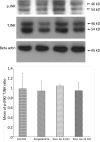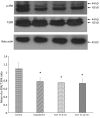The Effect of Intrahippocampal Insulin Injection on Scopolamine-induced Spatial Memory Impairment and Extracellular Signal-regulated Kinases Alteration
- PMID: 31031891
- PMCID: PMC6484185
- DOI: 10.32598/bcn.9.10.165
The Effect of Intrahippocampal Insulin Injection on Scopolamine-induced Spatial Memory Impairment and Extracellular Signal-regulated Kinases Alteration
Abstract
Introduction: It is well documented that insulin has neuroprotective and neuromodulator effects and can protect against different models of memory loss. Furthermore, cholinergic activity plays a significant role in memory, and scopolamine-induced memory loss is widely used as an experimental model of dementia. The current study aimed at investigating the possible effects of insulin against scopolamine-induced memory impairment in Wistar rat and its underlying molecular mechanisms.
Methods: Accordingly, animals were bilaterally cannulated in CA1, hippocampus. Intrahippocampal administration of insulin 6 MU and 12 MU in CA1 per day was performed during first 6 days after surgery. During next four days, the animal's spatial learning and memory were assessed in Morris water maze test (three days of learning and one day of retention test). The animals received scopolamine (1 mg/kg) Intraperitoneally (IP) 30 minutes before the onset of behavioral tests in each day. In the last day, the hippocampi were dissected and the levels of MAPK (mitogen-activated protein kinases) and caspase-3 activation were analyzed by Western blot technique.
Results: The behavioral results showed that scopolamine impaired spatial learning and memory without activating casapase-3, P38, and JNK, but chronic pretreatment by both doses of insulin was unable to restore this spatial memory impairment. In addition, scopolamine significantly reduced Extracellular signal-Regulated Kinases (ERKs) activity and insulin was unable to restore this reduction. Results revealed that scopolamine-mediated memory loss was not associated with hippocampal damage.
Conclusion: Insulin as a neuroprotective agent cannot restore memory when there is no hippocampal damage. In addition, the neuromodulator effect of insulin is not potent enough to overwhelm scopolamine-mediated disruptions of synaptic neurotransmission.
Keywords: Alzheimer Disease; Apoptosis; Caspase-3; Cholinergic neurons; Mitogen-Activated Protein Kinases; Scopolamine.
Conflict of interest statement
Conflict of interest The authors declared no conflict of interest.
Figures








Similar articles
-
Insulin protects against Aβ-induced spatial memory impairment, hippocampal apoptosis and MAPKs signaling disruption.Neuropharmacology. 2014 Oct;85:113-20. doi: 10.1016/j.neuropharm.2014.01.036. Epub 2014 Jun 2. Neuropharmacology. 2014. PMID: 24881967
-
Agmatine protects against scopolamine-induced water maze performance impairment and hippocampal ERK and Akt inactivation.Neuropharmacology. 2012 Apr;62(5-6):2018-23. doi: 10.1016/j.neuropharm.2011.12.031. Epub 2012 Jan 10. Neuropharmacology. 2012. PMID: 22248637
-
Sub-chronic oral cinnamaldehyde treatment prevents scopolamine-induced memory retrieval deficit and hippocampal Akt and MAPK dysregulation in male mice.Neurol Res. 2020 Feb;42(2):99-107. doi: 10.1080/01616412.2019.1709142. Epub 2020 Jan 8. Neurol Res. 2020. PMID: 31910792
-
Cortico-hippocampal memory enhancing activity of hesperetin on scopolamine-induced amnesia in mice: role of antioxidant defense system, cholinergic neurotransmission and expression of BDNF.Metab Brain Dis. 2019 Aug;34(4):979-989. doi: 10.1007/s11011-019-00409-0. Epub 2019 Apr 4. Metab Brain Dis. 2019. PMID: 30949953
-
NNZ-2591, a novel diketopiperazine, prevented scopolamine-induced acute memory impairment in the adult rat.Behav Brain Res. 2010 Jul 11;210(2):221-8. doi: 10.1016/j.bbr.2010.02.039. Epub 2010 Feb 25. Behav Brain Res. 2010. PMID: 20188767
Cited by
-
Roles and Interaction of the MAPK Signaling Cascade in Aβ25-35-Induced Neurotoxicity Using an Isolated Primary Hippocampal Cell Culture System.Cell Mol Neurobiol. 2021 Oct;41(7):1497-1507. doi: 10.1007/s10571-020-00912-4. Epub 2020 Jun 29. Cell Mol Neurobiol. 2021. PMID: 32601776 Free PMC article.
-
Intranasal insulin and orexins to treat age-related cognitive decline.Physiol Behav. 2021 May 15;234:113370. doi: 10.1016/j.physbeh.2021.113370. Epub 2021 Feb 21. Physiol Behav. 2021. PMID: 33621561 Free PMC article. Review.
References
-
- Balaban H., Naziroglu M., Demirci K., Ovey I. S. (2016). The protective role of selenium on scopolamine-induced memory impairment, oxidative stress, and apoptosis in aged rats: The involvement of TRPM2 and TRPV1 channels. Molecular Neurobiology, 54(4), 2852–68. [DOI:10.1007/s12035-016-9835-0] - DOI - PubMed
LinkOut - more resources
Full Text Sources
Research Materials
Miscellaneous
